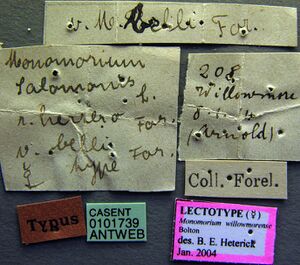Monomorium herero
| Monomorium herero | |
|---|---|

| |
| Scientific classification | |
| Kingdom: | Animalia |
| Phylum: | Arthropoda |
| Class: | Insecta |
| Order: | Hymenoptera |
| Family: | Formicidae |
| Subfamily: | Myrmicinae |
| Tribe: | Solenopsidini |
| Genus: | Monomorium |
| Species: | M. herero |
| Binomial name | |
| Monomorium herero Forel, 1910 | |
Nothing is known about the biology of Monomorium herero.
Identification
Bolton (1987) - A member of the M. subopacum complex in the M. salomonis species group. Monomorium herero remains an enigmatic species. It appears to be related to the South African Monomorium willowmorense and the Namibian Monomorium kitectum, but in both of these the cephalic sculpture is vestigial. Besides this kitectum is smaller than herero and has relatively larger eyes (HW 0.43-0.45, maximum diameter of eye 0.29-0.31 x HW), and willowmorense has decidedly shorter scapes (SI 88-93). In overall appearance herero approaches Monomorium subopacum, but has the head much less strongly sculptured and lacks the median clypeal notch or impression characteristic of the latter.
Keys including this Species
Distribution
Latitudinal Distribution Pattern
Latitudinal Range: -23.33333° to -31.56167°.
| North Temperate |
North Subtropical |
Tropical | South Subtropical |
South Temperate |
- Source: AntMaps
Distribution based on Regional Taxon Lists
Afrotropical Region: Namibia (type locality).
Distribution based on AntMaps
Distribution based on AntWeb specimens
Check data from AntWeb
Countries Occupied
| Number of countries occupied by this species based on AntWiki Regional Taxon Lists. In general, fewer countries occupied indicates a narrower range, while more countries indicates a more widespread species. |

|
Estimated Abundance
| Relative abundance based on number of AntMaps records per species (this species within the purple bar). Fewer records (to the left) indicates a less abundant/encountered species while more records (to the right) indicates more abundant/encountered species. |

|
Biology
Castes
Images from AntWeb

| |
| Paralectotype of Monomorium willowmorense. Worker. Specimen code casent0101654. Photographer Z. Lieberman, uploaded by California Academy of Sciences. | Owned by MHNG, Geneva, Switzerland. |

| |
| Paralectotype of Monomorium willowmorense. Worker. Specimen code casent0101681. Photographer Z. Lieberman, uploaded by California Academy of Sciences. | Owned by MHNG, Geneva, Switzerland. |

| |
| Paralectotype of Monomorium willowmorense. Worker. Specimen code casent0101739. Photographer Z. Lieberman, uploaded by California Academy of Sciences. | Owned by MHNG, Geneva, Switzerland. |
Nomenclature
The following information is derived from Barry Bolton's Online Catalogue of the Ants of the World.
- herero. Monomorium salomonis subsp. herero Forel, 1910f: 16 (w.q.) NAMIBIA (Possession I.).
- Type-material: syntype workers (number not stated), 1 syntype queen.
- Type-locality: Namibia: Possession I., v.1903 (L. Schultze).
- Type-depositories: BMNH, MHNG.
- [Misspelled as herrero by Santschi, 1936a: 39.]
- Combination in M. (Xeromyrmex): Wheeler, W.M. 1922a: 870.
- Subspecies of salomonis: Forel, 1914d: 245; Arnold, 1916: 222; Santschi, 1917b: 284; Wheeler, W.M. 1922a: 870; Emery, 1922e: 178; Arnold, 1944: 14; Ettershank, 1966: 89.
- Subspecies of delagoense: Santschi, 1936a: 39.
- Status as species: Bolton, 1987: 345 (redescription); Bolton, 1995b: 262.
- Distribution: Namibia.
Unless otherwise noted the text for the remainder of this section is reported from the publication that includes the original description.
Description
Worker
Bolton (1987) - TL 2.8-3.1, HL 0.70-0.78, HW 0.58-0.64, CI 78-83, SL 0.57-0.64, SI 99-100, PW 0.34-0.40, AL 0.80-0.90 (7 measured).
Median portion of clypeus with its anterior free margin transverse, not concave or indented. Maximum diameter of eye 0.24-0.26 x HW and with 10-11 ommatidia in the longest row. Sides of head evenly convex in full-face view, the occipital margin shallowly concave. Metanotal groove not or only very feebly impressed. Propodeal dorsum with a flattened triangular area, not concave, lacking sharp margins or rims to the triangular area. Dorsum of head with 2-3 pairs of standing hairs behind the level of the frontal lobes and with another pair situated close to the occipital corners. Dorsal alitrunk without standing hairs. Petiole with a single pair and postpetiole with 1-2 pairs of backward directed hairs. First gastral tergite with 2 pairs of hairs present in front of the apical transverse row, situated at approximately one-third and one-half of the length of the sclerite. Dorsum of head sculptured with reticulation only. Promesonotal dorsum reticulate anteriorly, the sculpture becoming stronger posteriorly and approaching the reticulate-punctate condition of the propodeal dorsum. First gastral tergite with faint superficial reticulate patterning only, shining. Sides of pronotum finely reticulate, remainder of sides of alitrunk reticulate-punctate. Colour uniform dark brown.
Type Material
Bolton (1987) - Syntype workers, female, Namibia: Possession I., v.1903 (L. Schultze) (Musee d'Histoire Naturelle Genève; The Natural History Museum) [examined].
References
- Bolton, B. 1987. A review of the Solenopsis genus-group and revision of Afrotropical Monomorium Mayr (Hymenoptera: Formicidae). Bulletin of the British Museum (Natural History). Entomology. 54: 263-452. (page 345, Raised to species)
- Forel, A. 1910e. Zoologische und anthropologische Ergebnisse einer Forschungsreise im westlichen und zentralen Südafrika ausgeführt in den Jahren 1903-1905 von Dr. Leonhard Schultze. Vierter Band. Systematik und Tiergeographie. D) Formicidae. Denkschr. Med.-Naturwiss. Ges. Jena 16: 1-30 (page 16, worker, queen described)
- Santschi, F. 1917b [1916]. Fourmis nouvelles de la Colonie du Cap, du Natal et de Rhodesia. Ann. Soc. Entomol. Fr. 85: 279-296 (page 284, Stirps of salomonis)
- Santschi, F. 1936a. Étude sur les fourmis du genre Monomorium Mayr. Bull. Soc. Sci. Nat. Maroc 16: 32-64 (page 39, Stirps of delagoense)
- Wheeler, W. M. 1922j. Ants of the American Museum Congo expedition. A contribution to the myrmecology of Africa. VIII. A synonymic list of the ants of the Ethiopian region. Bull. Am. Mus. Nat. Hist. 45: 711-1004 (page 870, Combination in M. (Xeromyrmex))
References based on Global Ant Biodiversity Informatics
- IZIKO South Africa Museum Collection

